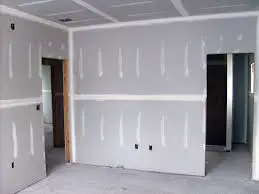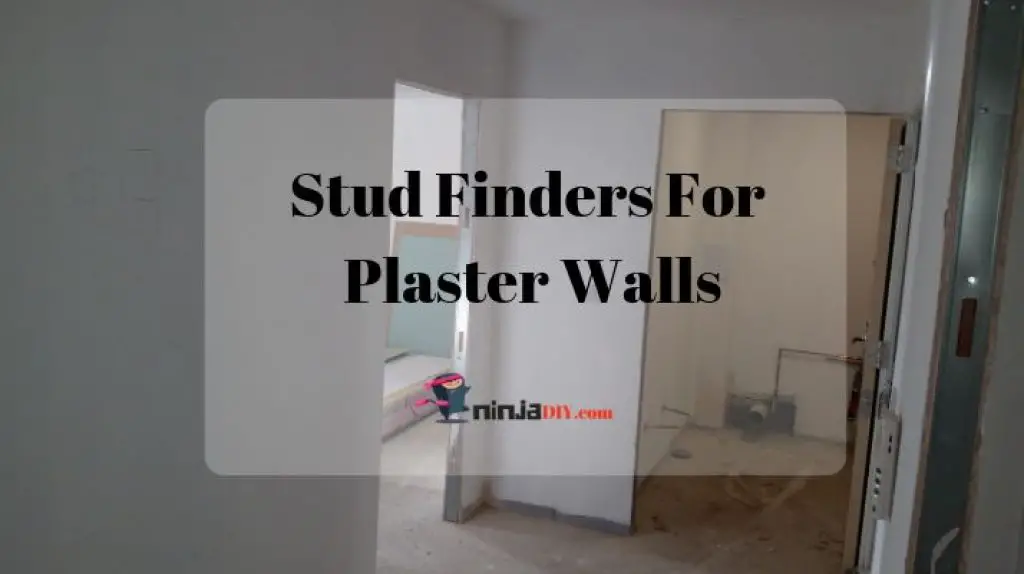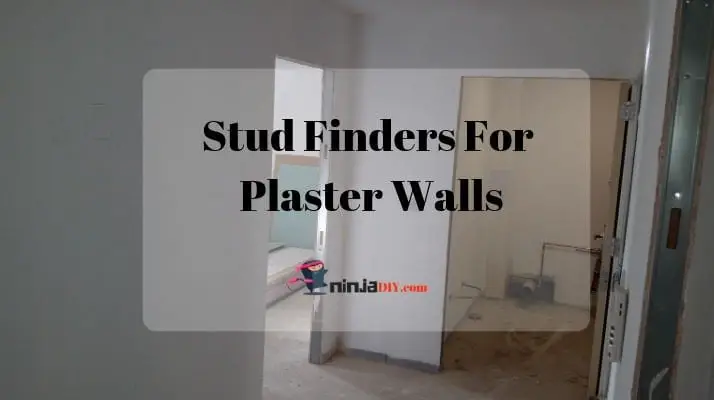Welcome to our best stud finder for plasterboard walls review round up for 2021.
Are you a builder, electrician, contractor or hobbyist and you have to work with plaster or having to do some tasks around plaster walls like hanging a tv or new shelves, etc? You’re probably wondering what’s the best stud finder for plaster walls in that case!
Great, because in today’s article, we’ll be discussing a fine selection of stud finders that are best suited for tasks that involve plaster walls.
I’ve seen and heard some horror stories about people drilling into walls not knowing what’s behind them and that’s what basically a stud finder will help you avoid!

These are some of the best quality tools a professional like yourself deserves. Most electronic stud finder models are generally inexpensive, but many users often complain about their usefulness on plaster walls.
More often than not, the surface textures on plaster walls and cables, live wires contained therein mess with the sensors on your run-of-the-mill electric stud finders. In such instances, homemade refrigerator magnet stud finders won’t do you any favors.
Any professional electrician, plumber or contractor worth his salt will tell you absolutely need to have a dedicated plaster wall stud finder.
The best part is, models built to hander plaster walls provide accurate readings on other surfaces as well as negating the need to get more than one stud finder. What’s even better, they can help detect all manner of materials buried behind walls.
From studs, nails, pipes, live electrical wiring and everything in-between, there’s not much these babies can’t do.
Before we dive in here is the stud finder devices I’ve selected for this task
Here’s what stud finders we’ve selected
Top 4 best stud finders for lath and plaster walls
I have selected four of the most reliable stud finders for plaster walls on today’s market.
1. Walabot DIY PLUS plaster wall stud detector
The Walabot DIY In-Wall Imager is designed for electricians, plumbers, civil engineers, and DIY enthusiasts. It works great for people working with plasterboard installations as well.
Walabot is powered by a scanner that plugs into a smartphone via a USB cable. The sensor is capable of penetrating up to a depth of 4 inches into walls, and ceilings and locate studs, metal pipes, plastic, and electrical wiring.
The setup works using an Android app that gives the user a visual representation of what the imaging device picks up behind walls, behind walls with tiles or concrete boards.
Key features of the Walabot DIY PLUS
- The RF feature allows it to detect a variety of materials behind a wall or surface you intend to drill or carry out repairs on.
- The device delivers an impressive degree of precision and is a must-have tool for any professional who values accuracy.
- Precision Radio Frequency Technology.
- The Walabot DIY In-Wall imager detects studs, pipes and electrical wiring using Radio Frequency Technology.
Walabot DIY is a versatile stud finder
The Walabot DIY In-Wall Imager has multiple scan modes which include picture mode, tangle mode and raw image mode which shows a red splotch on the phone’s screen even when it’s not placed against a wall.
Depending on the scan mode, you can vary the clarity of output to correctly determine stud or pipe locations inside your plaster walls.
The device can also help you detect rodents and other small annoying critters hiding behind your plaster walls.
Is it easy to use this Walabot app?
The Walabot DIY In-Wall imager is built to be as easy to use with the most accurate results as possible. The device is easy to set up and configure any amateur contractor or hobbyist would manage it.
You simply connect the scanner to your phone, configure the scanner and get to work in no time.
PROS
- The Walabot DIY imager is relatively easy to configure and operate. The Android app’s user interface is user-friendly and quite easy to work with.
- This tool is a feature-rich tool that offers impressive versatility and functionality at an affordable price.
- The unit is built to work seamlessly with Android smartphones. This makes it a powerful tool for professionals and hobbyists can rely on at any time.
CONS
- At the moment, Walabot DIY only works with Android smartphones.
If you’re curious, read full details and user’s opinions about this Walabot DIY Stud Finder App on Amazon
2. Vivreal Stud Finder 4 in 1 electric plaster wall detector
The Vivreal Stud Finder and wall scanner is another great professional stud finder best suited to take on projects involving plaster walls, concrete, and wood.
This stud finder comes equipped with 4 scanning modes that are capable of detecting studs, nails, pipes and electrical wiring.
The tool has both audible and LCD display warnings that alert the user whenever it picks up something you need to be alerted about.
Key features of the Vivreal stud finder
Live AC Wire Detection
This stud finder from Vivreal comes with a live wire detection feature that allows the user to avoid drilling through risk-prone live AC wires. This feature is a standard among most models designed for use on plaster walls.
Visual and Audible Notifications
The stud finder notifies the user when it detects studs or live wires behind a wall. It does this using a backlit LCD screen and an audible warning message that alerts you of objects hidden behind your wall.
Deep Stud Detection
The Vivreal wall scanner has four scan modes that can detect studs and ferrous materials such as rebar and pipes buried up to a depth of 1.5 inches.
Vivreal Consumer Impressions
PROS
- The devices ability to detect live wires is a welcome addition that sets apart the Vivreal Stud Finder Wall Scanner from most basic stud finders.
- For its price, the Vivreal Stud Finder Wall Scanner is a worthwhile pick thanks to a wide variety of features.
- The device automatically self-calibrates when turned on and positioned on a wall.
CONS
- The device doesn’t have any inbuilt mechanism that keeps it level on rough or textured walls. This can negatively impact the quality of results.
Click here to find out how much this Vivreal plaster and lath stud finder cost on Amazon.
3. Bosch GMS120: deep detection wall stud finder
Bosch is (as you probably already know) a very trusted brand in the construction equipment industry and the GMS120 is proof of their uncompromising quality.
The device comes in Bosch’s characteristic colors and a whole lot of features that set it apart from the competition. Let’s quickly see some more details about the Bosch gms120.
Features of this Bosch GMS120
User-Friendly Features
The GMS120 digital multi-scanner features an illuminated ring that clearly shows any detections alongside an audible signal with an on/off button.
Bosch added a user-focused design, excellent ergonomics, and a bright and readable illuminated graphical LCD display. The display indicates the scan mode, signal detection strength, and more
Consistent Coverage
The device has a precise automatic calibration feature that ensures accuracy is maintained throughout use and an automatic center finder. The latter pinpoints the center spot of material detected.
Armed with three scan modes, the Bosch GMS120 multi-scanner is perfect for most tasks whether professional or DIY. The three scan modes detect wood studs, metal objects such as nails, rebar, studs, and steel or copper pipes, and live AC wiring.
Deep Detection Mode
The GMS120 has a deep scan metal detection feature, which allows you to detect ferrous material that is buried up to a depth of 4-3/4-inches deep in plaster walls and cured concrete walls.
The device has a maximum detection depth of 2 inches for live AC wiring, 1.5 inches for wood studs, and up to 3-1/8 inches for copper.
Bosch GMS120 Consumer Impressions
PROS
- The GMS120 has a continuous automatic calibration feature that maintains consistent precision throughout projects. It’s also equipped with an automatic center finder.
- The device comes with three handy scan modes suitable for detecting wood, metal, wiring materials behind your plaster walls.
- This model has one of the most impressive scan depths of any stud finder in the market. It can detect ferrous materials buried up to a depth of 43/4.
CONS
- The stud detector is not able to differentiate between different materials and has been observed to fail at telling apart wooden studs from metal studs.
If you’re curious, read full details about this Bosch GMS120 Digital Stud Finder on Amazon
4. CH Hanson 03040 Magnetic Stud Finder
The CH Hanson 03040 is simple to use, features a compact minimalistic design encased in a tough, durable casing. Compared to its electronic counterparts, this magnetic stud finder comes at a fraction of the price of electronic stud finders.
To get started simply place the unit against a wall and slide along in the shape of an S figure. When it finds the screws or nails in the wall, it will stick to the wall.
This magnetic CH Hanson stud finder device is designed and built for professionals and DIY enthusiasts who prefer all things old school. If you love all things simple, then this magnetic stud finder may be exactly what you are looking for.
CH Hanson stud finder Features
1. No Batteries required
The 03040 does not require any batteries whatsoever and detects studs using powerful magnets. This stud finder can detect studs buried as deep as one inch with extreme accuracy.
2. Compact Size
This device is designed to be as small as possible with no compromise on its primary function. The 03040 will easily fit inside your pocket or toolbox. It features an ergonomic design and a soft grip all aimed at giving you maximum comfort.
3. Dual functionality
Other than being a pocket-sized magnetic stud finder, this device also doubles up as a two-way level which makes marking detection easy.
Consumer Impressions on the CH Hanson
PROS
- Being a magnetic stud finder, this device costs way less than electronic stud finders.
- CH Hanson stud finder does not need calibration, unlike its electronic counterparts.
- This device is built tough to withstand drops, tosses, and bangs. This makes its service life a lifelong affair and a tool you definitely need to have.
CONS
- This device cannot detect live AC wires which makes drilling plaster walls in hazard-prone areas a huge gamble.
If you’re curious, read full details about this CH Hanson magnetic stud detector on Amazon
Frequently Asked Questions
Here are some additional questions that you might have related to using stud finders on plasterboard walls that I thought it might be helpful!

Can you use a stud finder on plaster walls?
Absolutely, you can use a stud finder to detect pipes, live AC wiring, rebar, nails and more on plaster walls.
The catch, however, is that your stud finder of choice should be capable of maintaining precision on rough or textured surfaces such as a plaster wall.
There are several models discussed above that can achieve the task of detecting studs and other materials in plaster walls.
How do you find a stud in a plaster wall?
When trying to locate studs on a plaster wall, the first step is to acquire a suitable stud finder capable of scanning through rough or textured surfaces.
After initial setup and calibration, work through sections of plaster wall and mark any detected studs.
There are several models that you can choose from that will make detecting studs a walk in the park.
Does Walabot work on plaster walls?
Yes, the Walabot DIY In-Wall imager works great on plaster walls, cement walls, and wooden surfaces. The device works using Radio Frequency technology that essentially allows you to see what lies behind your plaster wall.
The device can detect a wide range of materials and can allow you to locate rodents and annoying critters hidden in your walls as well.
So What’s The Best Stud Finder For Plaster Walls?
In summary, when it comes to stud finders for plaster walls, there’s only one recommended protocol you should use when trying to find studs.
Get a high-quality stud finder that is sensitive enough to not only alert you when and where it detects studs, pipes, wires, nails and more, but also show you the center of the detected studs and their respective boundaries as well.
If you ask me, I’d go with the Walabot DIY.
Ninja Team Members Working On This Page

Adrian – Web Master / Construction Professional
Construction Professional, driver, crane operator, handyman … As a construction pro I love to get creative and see things done with my hands coming to life. Here I share with you some of the things I learn and hopefully you’ll get something out of it. Enjoy 🙂










Hi Adrian,
I have a home with mostly plaster and lath and some remodeling with sheetrock. With the CH Hanson I can find the stud nails in the sheetrock pretty easily. I cannot find them in the plaster and lath. It’s pretty strong magnet. If I get neat the electrical box edges, it sticks like glue.